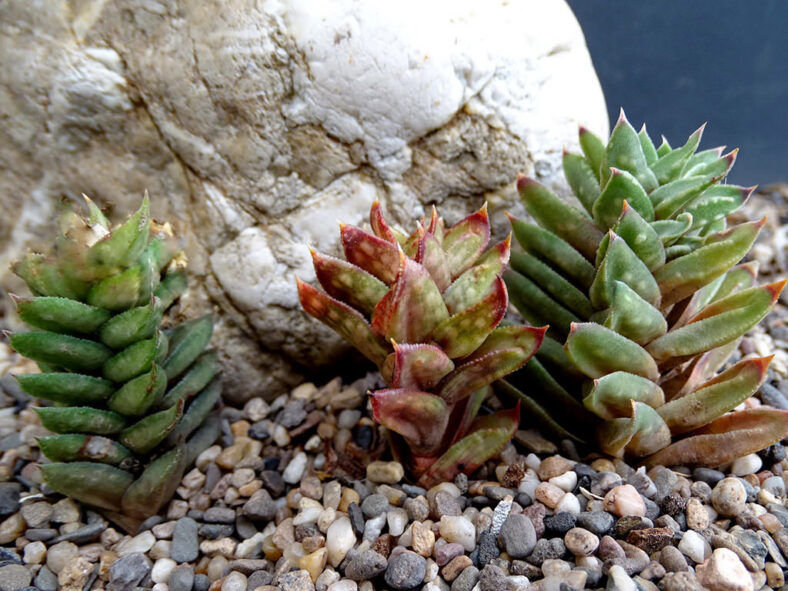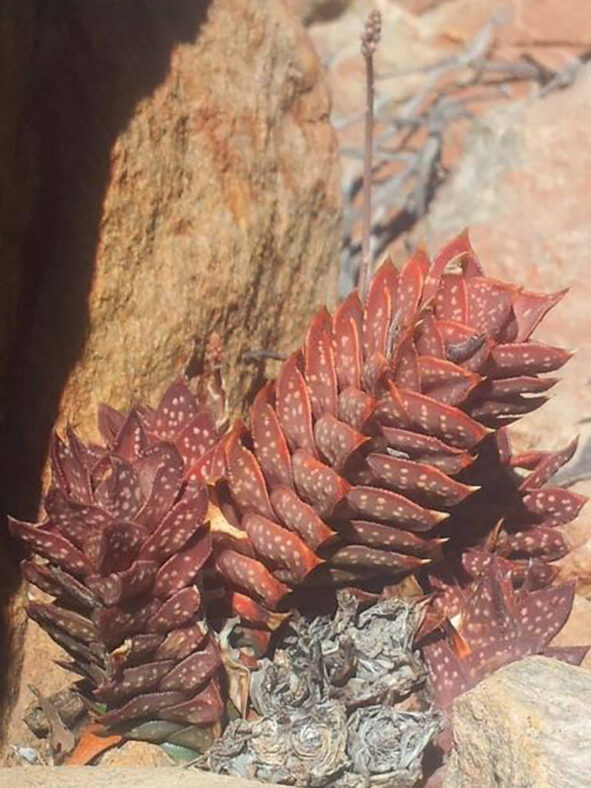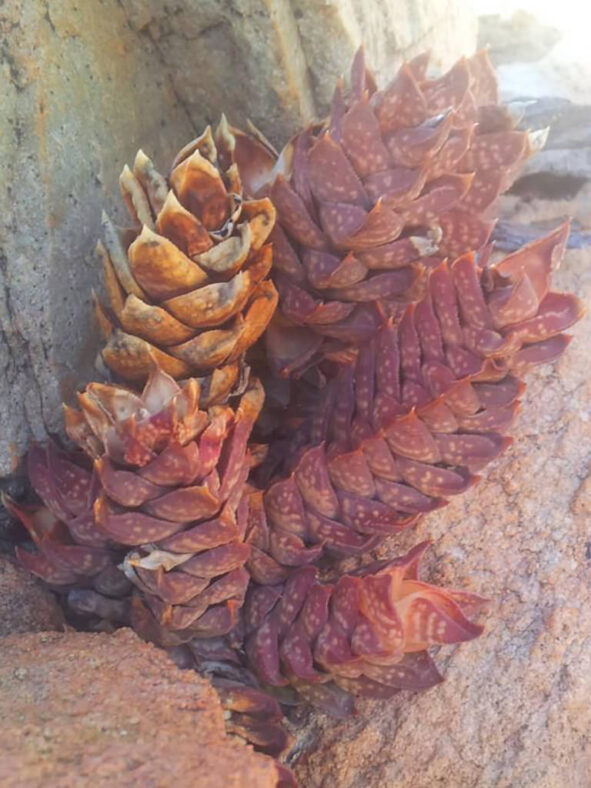Astroloba cremnophila closely resembles Astroloba bullulata. Although their inflorescences are nearly identical, this species can be distinguished by its spreading to pendent branches and distinct leaf shape and color.
Scientific Name
Astroloba cremnophila van Jaarsv.
Common Name(s)
Cliff Astroloba
Scientific Classification
Family: Asphodelaceae
Subfamily: Asphodeloideae
Genus: Astroloba
Etymology
The specific epithet "cremnophila" (pronounced "krem-noh-FIL-uh") means "cliff-loving" and refers to the cliff-dwelling habitat of this species.
Origin
Astroloba cremnophila is native to South Africa. It occurs on sheer cliff faces at Buffelspoort in the Klein Karoo region of the Western Cape province.
Description
Astroloba cremnophila is a slow-growing succulent that forms dense clumps of branches covered in ascending, spirally arranged leaves. It branches from the base and can reach a diameter of 16 inches (40 cm), with branches growing as long as 8 inches (20 cm). Initially, the branches are upright but become spreading or pendulous as they mature. The leaves are glaucous-green with greenish-white tubercles and turn reddish-green during the summer. They are ovate-triangular, have finely toothed keels and margins, and are arranged in five spirally twisted rows. Each leaf can measure up to 1 inch (2.5 cm) long and 0.6 inches (1.5 cm) wide. The branches end in a central rosette, which can reach a diameter of 1.5 inches (3.8 cm).
In late spring and summer, Astroloba cremnophila produces grey-green, tubular flowers adorned with white stripes. The flowers can measure up to 0.45 inches (1.1 cm) long, and are arranged in the upper half to one-third of slender, unbranched stalks that can grow up to 18.4 inches (46 cm). The fruits are linear ovoid capsules.

How to Grow and Care for Astroloba cremnophila
Light: Astroloba cremnophila thrives when provided with some protection from direct sunlight. If it has spent the winter indoors, gradually move the plant outdoors into the bright sunlight to prevent sunburn.
Soil: This plant prefers well-draining soil and does not like its roots to remain wet for prolonged periods. You can use commercial soil for succulents or make your own potting mix.
Temperature: Astroloba cremnophila tolerates warmer temperatures in the summer but prefers cooler temperatures in the winter. It grows best in USDA Plant Hardiness Zones 10a to 11b, with average minimum winter temperatures ranging from 30 to 50 °F (-1.1 to 10 °C).
Watering: Water the plant thoroughly during its most active growth periods in spring and fall. Wait until the top of the soil dries out before watering again. Reduce the watering frequency when the plant's growth slows significantly in winter. When the plant is mostly dormant in summer, water it just enough to keep the leaves from shriveling.
Fertilizing: Although Astroloba cremnophila does not require much fertilizer, feeding it can encourage optimal growth. Use a water-soluble fertilizer only during the growing season.
Repotting: This plant can remain in the same pot for several years. To keep it healthy and happy, repot it into fresh soil every two to three years, ideally in spring or fall.
Propagation: Astroloba cremnophila can be easily propagated by offsets and cuttings, but can also be started from seeds. Remove the offsets and take cuttings during the growing season. Sow the seeds in spring or fall.
See more at How to Grow and Care for Astroloba.
Toxicity of Astroloba cremnophila
Astroloba cremnophila is considered non-toxic and safe around kids and pets.
Links
- Back to genus Astroloba
- Succupedia: Browse succulents by Scientific Name, Common Name, Genus, Family, USDA Hardiness Zone, Origin, or cacti by Genus
Photo Gallery
Click on a photo to see a larger version.


